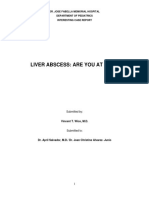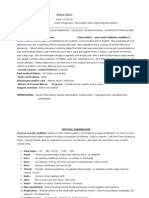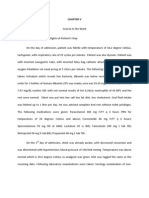0 ratings0% found this document useful (0 votes)
87 viewsClinical Abstract (2nd Sem 1st Rotation)
Clinical Abstract (2nd Sem 1st Rotation)
Uploaded by
Michael Gino SarenasThis clinical abstract summarizes the case of a 73-year-old male admitted for acute pancreatitis. He presented with abdominal pain and vomiting. His medical history includes diabetes, hypertension, and prior spinal surgery. Initial exams found epigastric tenderness. Imaging showed thickened pancreas. He was treated medically and underwent endoscopy. Labs showed inflammation and electrolyte abnormalities. He was transferred from ICU to a regular room as his condition stabilized with treatment and monitoring.
Copyright:
Attribution Non-Commercial (BY-NC)
Available Formats
Download as DOC, PDF, TXT or read online from Scribd
Clinical Abstract (2nd Sem 1st Rotation)
Clinical Abstract (2nd Sem 1st Rotation)
Uploaded by
Michael Gino Sarenas0 ratings0% found this document useful (0 votes)
87 views3 pagesThis clinical abstract summarizes the case of a 73-year-old male admitted for acute pancreatitis. He presented with abdominal pain and vomiting. His medical history includes diabetes, hypertension, and prior spinal surgery. Initial exams found epigastric tenderness. Imaging showed thickened pancreas. He was treated medically and underwent endoscopy. Labs showed inflammation and electrolyte abnormalities. He was transferred from ICU to a regular room as his condition stabilized with treatment and monitoring.
Copyright
© Attribution Non-Commercial (BY-NC)
Available Formats
DOC, PDF, TXT or read online from Scribd
Share this document
Did you find this document useful?
Is this content inappropriate?
This clinical abstract summarizes the case of a 73-year-old male admitted for acute pancreatitis. He presented with abdominal pain and vomiting. His medical history includes diabetes, hypertension, and prior spinal surgery. Initial exams found epigastric tenderness. Imaging showed thickened pancreas. He was treated medically and underwent endoscopy. Labs showed inflammation and electrolyte abnormalities. He was transferred from ICU to a regular room as his condition stabilized with treatment and monitoring.
Copyright:
Attribution Non-Commercial (BY-NC)
Available Formats
Download as DOC, PDF, TXT or read online from Scribd
Download as doc, pdf, or txt
0 ratings0% found this document useful (0 votes)
87 views3 pagesClinical Abstract (2nd Sem 1st Rotation)
Clinical Abstract (2nd Sem 1st Rotation)
Uploaded by
Michael Gino SarenasThis clinical abstract summarizes the case of a 73-year-old male admitted for acute pancreatitis. He presented with abdominal pain and vomiting. His medical history includes diabetes, hypertension, and prior spinal surgery. Initial exams found epigastric tenderness. Imaging showed thickened pancreas. He was treated medically and underwent endoscopy. Labs showed inflammation and electrolyte abnormalities. He was transferred from ICU to a regular room as his condition stabilized with treatment and monitoring.
Copyright:
Attribution Non-Commercial (BY-NC)
Available Formats
Download as DOC, PDF, TXT or read online from Scribd
Download as doc, pdf, or txt
You are on page 1of 3
Clinical Abstract
Submitted by: Michael Gino S. Sarenas
BSN IV-E, Group 4
I. Presentation of the Client
This the case of L.G.C., 73 year old male diagnosed with acute pancreatitis, diabetes
mellitus type 2, acute kidney injury on top of chronic kidney disease, and hypertension. Client
was born on February 17, 1937 and currently resides in Paranaque City.
History of present illness started eight hours prior to admission. Client had just eaten
breakfast when he suddenly experienced vague, severe epigastric pain, associated with four
episodes of vomiting with acidic tasted, non-bloody, non-bilious vomitus. He took domperidone
which offered no relief. Abdominal pain increased in severity to 10/10, radiating to the back,
which prompted consult and subsequent admission.
Past medical history reveals that client was diagnosed with Diabetes Mellitus type 2 and
was on maintenance medications: Metformin (500mg) and Glimepiride (2mg). Client also has
hypertension and takes Ramipril (10mg). Client also had a spinal surgery in 2006.
Family history reveals that both mother and father’s side has history of hypertension and
diabetes mellitus type 2. Personal history reveals that client is fond of eating fatty and oily foods,
a previous alcoholic beverage drinker and a non-smoker.
On the day of admission last November 8, 2010, client had a chief complaint of
abdominal pain and chills. Client was conscious and coherent, not in distress, and comfortable.
Vital signs reveal temperature of 36.5 °C, HR: 108, RR: 26, BP: 150/80, PS: 10/10. Client has
anicteric sclera, pink conjunctivae, no lymphadenopathies, no neck vein distention, equalchest
expansion, clear breath sounds, globular abdomen, normoactive bowel sounds, and soft. Severe
epigastric pain tenderness, liver not enlarged. Client is not cyanotic, not edematous, and has full
pulses.
Ultrasound of whole abdomen shows that pancreas appears thickened although no focal
lesions were seen. The spleen is normal in size and homogenous in echopattern.
1740H: client was admitted under the service of Dr. J.D.F. Vital signs are to be
monitored every 4 hours.
2115H: client was in orthopaedic device on cervical area, less abdominal pain with grade
of 4/10, nonradiating. BP: 140/80, 80 bpm, afebrile, clear breath sounds, abdomen is flabby,
normoactive bowel sounds, soft, nontender.
2130H: client was ordered for esophagogastroduodenoscopy at 0845 the following day,
nothing per orem was also ordered.
2230H: capillary blood glucose monitoring was ordered to be monitored every 4 hours,
results to be relayed. Insulin novorapid 5 units subcutaneously for CBG of more than 200 mg/dL
was also ordered.
November 9 at 1019H-1023H: esophagogastroduodenoscopy was performed by Dr. E.F.
November 10: arterial blood gas results reveal PO2- 67.8; pH- 7.43; PCO2- 30.2; HCO3-
19.9; O2 sat.- 94.4% with an interpretation of compensated respiratory alkalosis.
2-D echocardiogram shows aortic wall calcification, aortic and mitral annuli calcification.
Calcified margins of right and non-coronary cusps of the valve leaflet with normal leaflet
nobility. Color flow and Doppler study: mitral regurgitation, trace. Reversed mitral E/A ratio
indicative of decreased left ventricular relaxation.
November 12: chest x-ray shows that follow-up study after one day shows hilar or
parahilar haziness which couls be due to pulmonary congestion. The heart is not enlarged. The
rest of the chest structures are the same.
November 15 at 0749H: haemoglobin- 11.80 g/dL (n.v.- 14.-17.5), hematocrit- 34.3%
(n.v.- 41.5-50.4), RBC- 3.74 x106/uL (n.v.- 4.5-5.9), WBC- 13.04 x 103 u/L (n.v.- 4.4-11.0),
basophils- 2% (n.v.- 0-1), segmenters- 80% (n.v.- 40-70), lymphocytes- 3% (n.v.- 22-43),
monocytes- 11% (0-7).
0750H: nephrology noted that client can tolerate feeding, no abdominal pain, or
tenderness. BP: 130/70, HR: 80bpm, with crackles on right base of lung.
0920H: CBG: 125-162 mg/dL (stable)
1034H: clinical chemistry of blood shows liver function test- ALT (SGPT)- 52 u/L (n.v.-
10-50), alkaline Phosphatase- 254 u/L (n.v.- 110-130), and albumin- 30 g/L (n.v.- 35-52)
1045H: Dr. E.F. noted that client has not enough calories in the diet. Client was ordered
to have full liquid diet, strictly low fat, Vamin glucose was recommended to be retained until
there are enough oral or enteral calories. Oral feeding was ordered to be held if client develops
abdominal pain. Client may also have decaffeinated coffee, no regular coffee or dairy products.
1340H: endocrinology had no objection for client to be transferred to regular room, as
well as cardiology.
1400H: Student nurse was assigned to MICU 7 and received endorsement, reviewed
client’s chart and medications. Student nurse performed initial assessment upon introduction to
client. Received client in moderate back rest with nasogastric tube clamped, O2 cannula at 4 liters
per min, intravenous secalon at right antecubital vein with ongoing intravenous fluids of:
catapres 150mg in D5W 100ml, nicardipine 20 mg drip in NSS 80ml, and PNSS 500x20 ml/hr,
pulse oximeter at right index finger, voiding freely. Client is conscious, coherent, and responsive
to pain stimulation. Pupils equally round, reactive to light accommodation, anicteric sclera, pink
conjunctiva, no palpable lymph nodes, equal chest expansion, crackles on left lower lobe. Bowel
sounds are normoactive, non-distended stomach, tender on left upper quadrant (4/10), non-
radiating, no nodules or palpable masses. Bladder is not distended, with yellow urine. Vital signs
are 36.7 °C; 88 bpm; 25 cpm; 130/90; 4/10. In previous assessment, client noted tenderness on
left upper quadrant of abdomen. Deep breathing exercises were taught. Diversional activities
such as listening to the radio were also encouraged. Client was also encouraged to rest and have
a relaxed mood. Lights were dimmed and performed nursing procedures at ease to prevent
disturbing the client’s rest period.
1500H: diaper was changed and performed back clapping and turned client to side.
Nasogastric tube was drained 15 minutes prior, patency of tube was also checked, and prescribed
osterized feeding was given with a tolerable flow rate. Vital signs were recorded: 36.5 °C; 80
bpm; 22 cpm; 130/80; 3/10.
1530H: feeding was consumed, assisted bedside nurse in administration of medications,
and nasogastric tubing was clamped.
1600H: student nurse gathered all things of the client for transfer to a regular room. Vital
signs were recorded: 36.6 °C; 82 bpm; 22 cpm; 120/80; 0/10. Client can no longer feel any pain
on left upper quadrant and was in a relaxed mood. Client was turned to side and performed back
clapping and encouraged deep breathing exercises. Client was also taught about ROM exercises
such as stretching of arms and feet, and head rotation. Client performed the exercises with ease.
1645H: pulse oximeter was ordered to be discontinued and as well as cardiac monitor
when transferred to room.
1700H: client was transferred to a regular room, endorsed client to the receiving bedside
nurse, bade goodbye and said ‘thank you’, student nurse-client interaction terminated.
II. Problem list:
1. Impaired gas exchange related to ventilation perfusion imbalance as evidenced by
abnormal ABG results (compensated respiratory alkalosis) and RR= 25 cpm
2. Acute pain related to inflammatory processes as evidenced by piercing-like pain on
left upper quadrant with a scale of 4/10
3. Risk for imbalanced nutrition: less than body requirements related to inability to
ingest food
4. Risk for infection related to necrotic pancreatic tissue
5. Risk for activity intolerance related to prolonged bed rest
You might also like
- Vincent Brody Care PlanDocument10 pagesVincent Brody Care PlanKarina Rodriguez50% (2)
- Case Study in Competency Appraisal II - ABC and EDNDocument5 pagesCase Study in Competency Appraisal II - ABC and EDNRogelio Saupan Jr100% (1)
- CPC-Patho Version 6Document20 pagesCPC-Patho Version 6Bea SamonteNo ratings yet
- SABER-Nursing Care Plan #1 - JGDocument7 pagesSABER-Nursing Care Plan #1 - JGJessica MontoyaNo ratings yet
- The CaseDocument33 pagesThe CasemarunxNo ratings yet
- Soap NotesDocument4 pagesSoap NotesLatora Gardner Boswell100% (3)
- CCRN PulmonaryDocument107 pagesCCRN PulmonaryCzarina Charmaine Diwa100% (4)
- Case Protocol M&MDocument5 pagesCase Protocol M&Mcharmaine BallanoNo ratings yet
- KROK 2 1 профиль (315 Q 2004-2005)Document54 pagesKROK 2 1 профиль (315 Q 2004-2005)Ali ZeeshanNo ratings yet
- Sample Name: Abscess With Cellulitis - Discharge SummaryDocument3 pagesSample Name: Abscess With Cellulitis - Discharge Summaryravip3366No ratings yet
- Danganan Protocol Ver 2Document7 pagesDanganan Protocol Ver 2FayeListancoNo ratings yet
- General Medicine Praticals. FinalDocument22 pagesGeneral Medicine Praticals. FinalPharmacology RIMS SklmNo ratings yet
- Written Case Report HADocument7 pagesWritten Case Report HAJoan junioNo ratings yet
- EnCoding 1Document6 pagesEnCoding 1WoHoNo ratings yet
- 2 5357496407794142197Document30 pages2 5357496407794142197David KpelleNo ratings yet
- 'Batangas Medical Center Case Report by PGI Carlos H. AcuñaDocument7 pages'Batangas Medical Center Case Report by PGI Carlos H. AcuñaCarlos H. AcuñaNo ratings yet
- Cardio Case StudentDocument5 pagesCardio Case StudentReynald Ddc ShiroNo ratings yet
- Pathophysiology, Diagnosis,: and Treatment of The Postobstructive DiuresisDocument2 pagesPathophysiology, Diagnosis,: and Treatment of The Postobstructive DiuresisJohannes MarpaungNo ratings yet
- NIICU Clinical Database #1Document10 pagesNIICU Clinical Database #1angela0289No ratings yet
- SurgeryDocument24 pagesSurgeryHikufe JesayaNo ratings yet
- Lopez, Lovelle Nmd-ClerkDocument11 pagesLopez, Lovelle Nmd-ClerkLovelle LopezNo ratings yet
- Diabetic KetoacidosisDocument5 pagesDiabetic KetoacidosisJamie IllmaticNo ratings yet
- Therapy ModuleDocument39 pagesTherapy ModuleSuruchi Jagdish SharmaNo ratings yet
- Ujian Tulis Ipd Grup C AnswerDocument10 pagesUjian Tulis Ipd Grup C AnswerHartantoRezaGazaliNo ratings yet
- Case PresentationDocument48 pagesCase Presentationasrakhaleeq05No ratings yet
- Case PresDocument39 pagesCase Pres7vjkgkw29xNo ratings yet
- PracticeExam 2 QsDocument24 pagesPracticeExam 2 QsBehrouz YariNo ratings yet
- Progress NoteDocument2 pagesProgress NoteZahraa MustafaNo ratings yet
- Nursing Care Plan PackageCDocument23 pagesNursing Care Plan PackageCralsadat100% (1)
- Case Report - Diabetes MellitusDocument19 pagesCase Report - Diabetes MellitusAnggitafhNo ratings yet
- Gastroenterology Cases (BLOCK 1)Document6 pagesGastroenterology Cases (BLOCK 1)voltaireukNo ratings yet
- Soal - To1 (MHS) - 1Document46 pagesSoal - To1 (MHS) - 1Ghina ApriyaniNo ratings yet
- (KASUS-ENDOKRIN) (2023-10-24) A HYPEROSMOLAR HYPERGLYCEMIC STATE (HHS) PATIENT WITH NEUROLOGICAL MANIFESTATION INVOLUNTARY MOVEMENT (Biyan Maulana)Document11 pages(KASUS-ENDOKRIN) (2023-10-24) A HYPEROSMOLAR HYPERGLYCEMIC STATE (HHS) PATIENT WITH NEUROLOGICAL MANIFESTATION INVOLUNTARY MOVEMENT (Biyan Maulana)ANo ratings yet
- 132 Emergency MedicineDocument14 pages132 Emergency MedicineVania NandaNo ratings yet
- The Outline of Writing TaskDocument8 pagesThe Outline of Writing TaskDinda Rahma DewiNo ratings yet
- IcuDocument12 pagesIcueint8928No ratings yet
- 13 Levels of AssessmentDocument11 pages13 Levels of AssessmentCatherine Cayda dela Cruz-BenjaminNo ratings yet
- Acute Pancreatitis Case PresDocument29 pagesAcute Pancreatitis Case Preskristine keen buan100% (1)
- Stroke in Covid May 2021Document6 pagesStroke in Covid May 2021Louie MercadoNo ratings yet
- Case Presentation RADocument6 pagesCase Presentation RAdocv526No ratings yet
- IM Case ReportDocument5 pagesIM Case ReportGurungSurajNo ratings yet
- Major Case 3Document3 pagesMajor Case 3Christine Evan HoNo ratings yet
- Chapter VDocument15 pagesChapter VJellou MacNo ratings yet
- nsg-320cc Care Plan 1Document14 pagesnsg-320cc Care Plan 1api-509452165No ratings yet
- Cannabinoid Hyperemesis SyndromeDocument24 pagesCannabinoid Hyperemesis SyndromeEmily EresumaNo ratings yet
- Case 1Document4 pagesCase 1chikinlam900No ratings yet
- Valvular Dysfuction StudentDocument2 pagesValvular Dysfuction StudentBest of pinoyNo ratings yet
- Client Information Sheet (CIS)Document10 pagesClient Information Sheet (CIS)Christine RombawaNo ratings yet
- Yabani A. Mkunji. CasesDocument31 pagesYabani A. Mkunji. CasesElizabeth CharlesNo ratings yet
- Chapter ThreeDocument9 pagesChapter ThreeTreskarho RenzoNo ratings yet
- pneumonia (1)Document6 pagespneumonia (1)ma202363082048No ratings yet
- Cases Word 2Document58 pagesCases Word 2Danger PrinceNo ratings yet
- Prework 3rd Week NCM 118bDocument2 pagesPrework 3rd Week NCM 118beatingchoiceNo ratings yet
- Clerk GCPDocument19 pagesClerk GCPNikki DiocampoNo ratings yet
- Surgery Furaha Case 2Document7 pagesSurgery Furaha Case 2Elizabeth CharlesNo ratings yet
- Falciparum Malaria Complicated With Acute Pancreatitis: A Report of Case SeriesDocument3 pagesFalciparum Malaria Complicated With Acute Pancreatitis: A Report of Case SeriesMuhammad Taufik AdhyatmaNo ratings yet
- Department of Internal Medicine: Manila Doctors HospitalDocument5 pagesDepartment of Internal Medicine: Manila Doctors HospitalFayeListanco100% (1)
- Jurnal Lapsus Efusi Pericardium - InggrisDocument8 pagesJurnal Lapsus Efusi Pericardium - Inggriswilliamlomban8No ratings yet
- EMQsDocument30 pagesEMQsnob2011nob100% (1)
- Case Protocol Grandrounds COVDocument7 pagesCase Protocol Grandrounds COVFayeListancoNo ratings yet
- BSN 3-A-Group 3 - Logical Framework AnalysisDocument5 pagesBSN 3-A-Group 3 - Logical Framework AnalysisCarlos Miguel OronceNo ratings yet
- 2Document10 pages2yalahopaNo ratings yet
- Question:Discuss Various Malignancies of The Oral Region AnswersDocument6 pagesQuestion:Discuss Various Malignancies of The Oral Region AnswersMahdaba sheikh MohamudNo ratings yet
- Beyond Traumatic Brain InjuryDocument3 pagesBeyond Traumatic Brain Injuryiffat565No ratings yet
- PSM EdgeDocument2 pagesPSM EdgeskNo ratings yet
- (Blood Glucose) Department of Public Health Spring 2020, Lab Manual (PBH101L)Document2 pages(Blood Glucose) Department of Public Health Spring 2020, Lab Manual (PBH101L)Afia Nazmul 1813081630No ratings yet
- Occupational Dermatoses2Document3 pagesOccupational Dermatoses2Alaa BahjatNo ratings yet
- April 1997 Paper 1 Clinical Nursing Essay - Type Test Items: Scenario 1 Item 1Document3 pagesApril 1997 Paper 1 Clinical Nursing Essay - Type Test Items: Scenario 1 Item 1Aaron WallaceNo ratings yet
- Aplastic Anemia Lecture 1aDocument39 pagesAplastic Anemia Lecture 1aniaaseta100% (2)
- Lymphomas of The Head and Neck - Practice Essentials, Background, PathophysiologyDocument6 pagesLymphomas of The Head and Neck - Practice Essentials, Background, Pathophysiologymiranddaelvira02No ratings yet
- Omohyoid SyndromeDocument4 pagesOmohyoid SyndromeibrahimlutfiNo ratings yet
- Kelompok 1 BURNDocument10 pagesKelompok 1 BURNRido SyahNo ratings yet
- Acute Post-Streptococcal GlomerulonephritisDocument27 pagesAcute Post-Streptococcal GlomerulonephritisAlokh Saha RajNo ratings yet
- Pediatric Lymphomas and Solid Tumors 0Document153 pagesPediatric Lymphomas and Solid Tumors 0yogendra madanNo ratings yet
- Tarlac State UniversityDocument11 pagesTarlac State UniversityJenica DancilNo ratings yet
- Emergency Nursing: C. Emergency Care EnvironmentDocument23 pagesEmergency Nursing: C. Emergency Care EnvironmentJ Russel Dichoso100% (2)
- Prostate Cancer Treatment in India Detailed InformationDocument3 pagesProstate Cancer Treatment in India Detailed InformationinadorNo ratings yet
- MALPRESENTATIONDocument13 pagesMALPRESENTATIONLady Jane CaguladaNo ratings yet
- Laporan Kasus Tonsilitis KronisDocument49 pagesLaporan Kasus Tonsilitis KronisTabita P SNo ratings yet
- Arthritis DissertationDocument4 pagesArthritis DissertationBuyALiteratureReviewPaperUK100% (1)
- Principles of Oncology NursingDocument12 pagesPrinciples of Oncology NursingДария Коваленко100% (2)
- ArtykułDocument3 pagesArtykułk.m.cierpialNo ratings yet
- Simple PA Summary - LaoDocument3 pagesSimple PA Summary - Laonoinoilao7355No ratings yet
- Hyperemesis Gravidarum PresentationDocument22 pagesHyperemesis Gravidarum PresentationMaricar Sanson FelicianoNo ratings yet
- N 136 Case StudyDocument3 pagesN 136 Case StudyYEM SokhaNo ratings yet
- Abnormal GaitDocument14 pagesAbnormal GaitAbolfazlNo ratings yet
- Nursing Care Plan CancerDocument1 pageNursing Care Plan CancerAbhishek SoniNo ratings yet
- All KashaayamsDocument8 pagesAll KashaayamsSamhitha Ayurvedic ChennaiNo ratings yet
- Pedia MKD Notes and OthersDocument18 pagesPedia MKD Notes and OthersRamon GodienesNo ratings yet

























































































